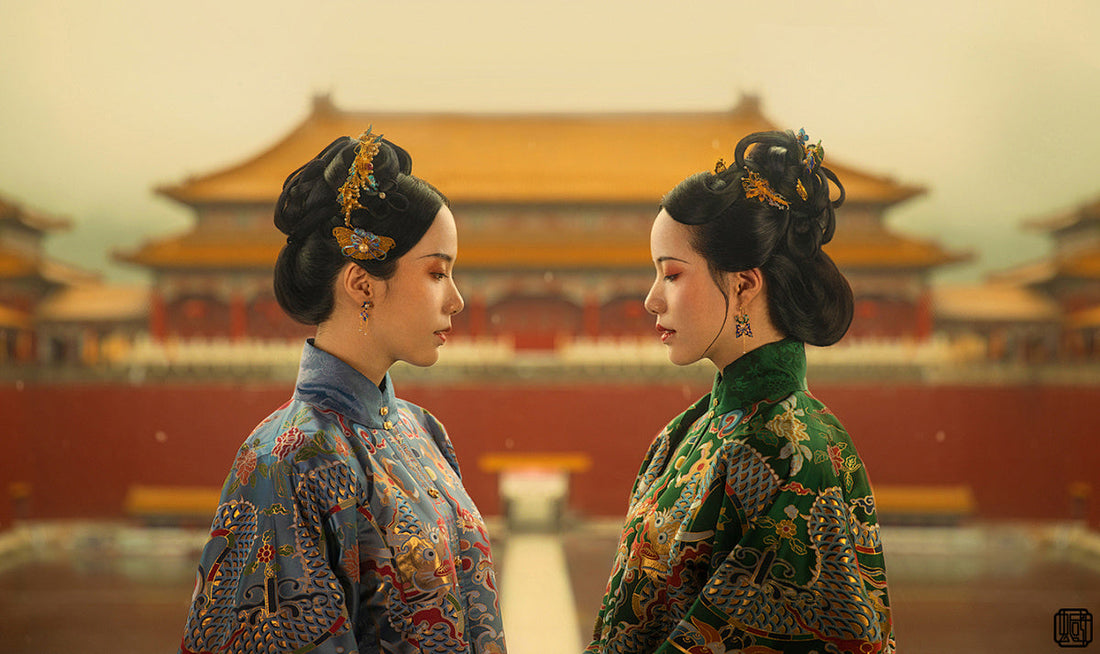
Journey Through Dynasties: A History of Chinese Adornment and Symbolism
Compartir
Jewelry is more than mere decoration; it is a silent historian. In the magnificent, sweeping story of Chinese civilization, adornment has served as a powerful narrator, reflecting the philosophies, spiritual beliefs, social structures, and aesthetics of each great dynasty. From the primal beauty of Neolithic cultures to the opulent splendor of the Qing court, each era left its unique mark on the art of jewelry.
To understand this history is to appreciate the profound depth and meaning woven into the Chinese-inspired pieces we cherish today. At Jambhala & Jewelry, we are deeply moved by this legacy, drawing inspiration from the timeless symbols and materials that have journeyed through these dynasties. Let's embark on a brief journey through time.
Neolithic Era (c. 10,000–2,000 BCE): The Dawn of Adornment
- The Materials: The earliest forms of adornment were crafted from nature's raw gifts: animal bones, teeth, shells, and most significantly, stone. This is where the reverence for Jade began, prized for its toughness and beautiful color, painstakingly ground and polished into ritual objects and simple pendants.
- The Symbolism: Adornment was deeply tied to survival, spirituality, and tribal identity. Pieces were likely worn as amulets for protection, as status symbols for chieftains, or as conduits to the spirit world. The focus was on raw, primal power.
Shang Dynasty (c. 1600–1046 BCE): Bronze, Power, and the Ancestors
- The Materials: This era saw incredible advancements in bronze casting. While Jade carving became more refined, the discovery of Turquoise as a precious material for inlay is a hallmark of this period. Stunning examples of bronze inlaid with Turquoise have been found in the tombs of royalty, like that of the warrior queen Fu Hao.
- The Symbolism: Jewelry was a key indicator of rank and a tool for communicating with ancestors and gods. Motifs like the taotie (a mythical, protective creature) and early forms of dragons and phoenixes emerged, symbolizing immense power and divine authority.
Zhou and Han Dynasties (c. 1046 BCE–220 CE): Order, Philosophy, and the Silk Road
- The Materials: Jade carving reached new heights of artistry and philosophical importance. The opening of the Silk Road brought new materials and influences. Glass beads became more common, and the use of gold and silver began to flourish.
- The Symbolism: This was the age of great philosophies like Confucianism and Daoism. Jewelry reflected these ideals. Jade came to symbolize the Confucian ideal of the perfected gentleman – embodying virtues of benevolence, integrity, and wisdom. Symbols of harmony, balance, and longevity became more prevalent.
Tang Dynasty (618–907 CE): A Golden Age of Opulence and Cosmopolitanism
- The Materials: The Tang Dynasty was a cultural zenith, open to foreign influences via the Silk Road. The use of gold and silver became widespread and masterful, often decorated with intricate filigree and granulation. Precious stones like pearls, sapphires, and fiery red Agates were highly fashionable.
- The Symbolism: The style was bold, lavish, and confident. Motifs from Persian and Central Asian cultures blended with traditional Chinese symbols. The Phoenix and Peony were particularly popular, representing feminine beauty, grace, and prosperity, reflecting a period of immense cultural confidence and wealth.
Song and Ming Dynasties (960–1644 CE): Refined Elegance and Scholarly Taste
- The Materials: These eras saw a return to a more restrained, elegant, and scholarly aesthetic. While gold and precious stones were still used, there was a renewed emphasis on the subtle beauty of materials like Jade, Amber, and beautifully carved organic materials. The appreciation for the warm, ancient quality of Amber grew, especially within Buddhist traditions.
- The Symbolism: The focus shifted to understated elegance and intellectual pursuits. Designs became more delicate and naturalistic, with motifs of flowers, birds, and serene landscapes reflecting a desire for harmony with nature and a contemplative spirit.
Qing Dynasty (1644–1912 CE): The Pinnacle of Intricate Craftsmanship
- The Materials: The Qing court is renowned for its dazzling and incredibly intricate adornments. Craftsmanship reached a pinnacle, with masterpieces created from gold, pearls, kingfisher feathers, and a vast array of gemstones, including prized Nan Hong Agate for its auspicious red color. The use of Dzi Beads from Tibet also became more prominent among the Buddhist imperial family.
- The Symbolism: Symbolism was highly codified and complex. Every element of an empress's headdress or an official's court necklace conveyed specific meanings of rank, occasion, and auspicious blessings. Dragons, phoenixes, bats, and endless knots were rendered with breathtaking detail.
The Jambhala & Jewelry Legacy: Ancient Wisdom for a Modern World
This incredible journey through the dynasties informs every piece we create at Jambhala & Jewelry. We are not just making jewelry; we are curating a legacy.
- We choose materials like Agate, Nan Hong, Turquoise, Amber, Chalcedony, and Dzi Beads because they have been cherished and proven through the test of time.
- Our Chinese-inspired designs honor the timeless symbols of protection, harmony, and good fortune.
- Our sacred energy blessing is our modern way of imbuing our pieces with the same kind of powerful intention that was bestowed upon the talismans of emperors and sages.
When you wear a piece from our collection, you are wearing a story that is thousands of years old. You are connecting with the enduring spirit of Chinese adornment – a tradition that has always understood that what we wear is a powerful expression of who we are and the energy we wish to cultivate.





























